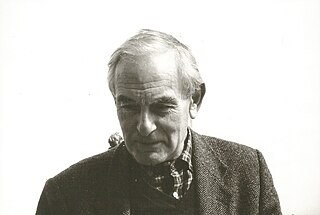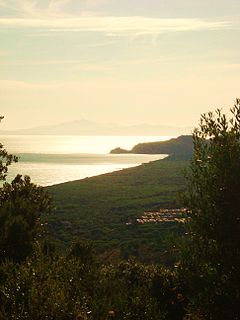
Lucos Cozza was a Roman archaeologist.
Canicattini Bagni is a comune (municipality) in the Province of Syracuse, Sicily (Italy), located about 190 kilometres (120 mi) southeast of Palermo and about 20 kilometres (12 mi) southwest of Syracuse. As of 31 December 2004, it had a population of 7,415 and an area of 15.1 square kilometres (5.8 sq mi).

The Badia a Settimo or Abbazia dei Santi Salvatore e Lorenzo a Settimo is a Cluniac Benedictine abbey in the comune of Scandicci, near Florence in Tuscany, Italy. It was founded in 1004.

Piero Calamandrei was an Italian author, jurist, soldier, university professor, and politician. Born in Florence, he was one of Italy's leading authorities on the law of civil procedure.

Antonio Randa was an Italian painter of the classicist period, active in Ferrara, Modena, Rovigo, Florence, Comacchio and his native Bologna.

Fabrizio de Miranda was an Italian bridges and structural engineer and university professor.
Massimo Carmassi is an Italian architect.

Palazzo Gherardi is a 15th-century building in the Santa croce quarter of Florence, Tuscany, in central Italy. Its main façade is on Via Ghibellina 88, while to the right it faces Via dei Pepi.

Paolo Del Bianco, is president of the Romualdo Del Bianco Foundation, member of the ICOMOS Hungary Committee, member of the ICOMOS International Scientific Committee for Theory and Philosophy of Conservation and Restoration, honorary member of the ICOMOS International Scientific Committee for Mural Paintings, promoter and founder of Life Beyond Tourism Non Profit Portal, President of Centro Congressi al Duomo - CCAD Firenze affiliate member UNWTO.
Urban iconography is a branch of iconography, a term used both extensively, to mean a collection of illustrations of a specific subject and, within art history, the study of the subject matter of figurative representations. Iconology is more specifically concerned with the interpretation of the same subject matter. According to Erwin Panofsky iconography aims to identify the primary and secondary subject matter, and therefore “in doing so, iconography is an invaluable help for the establishment of dates, provenance and, occasionally, authenticity; and it furnishes the necessary basis for all further interpretation”. Urban iconography is focused on the city, a complex and dynamic artifact, whose forms are a transparent medium of social ideas, individual and collective needs, like dwelling or gathering for religious, economic or political purposes, needs to which different societies gave different answers. To interpret town images correctly, it is necessary to understand the urban mechanisms of evolution, as well as urban culture. On the other hand, the image itself is part of the wider history of figurative handcrafts, and therefore. deciphering its representative code is essential to guarantee a proper interpretation and a proper use.

Roccamare is a village in Tuscany, central Italy, administratively a frazione of the comune of Castiglione della Pescaia, province of Grosseto. At the time of the 2001 census its population amounted to 107.

Palazzo Natoli is a Baroque palace in Palermo, in the Mediterranean island of Sicily. It was built by Vincenzo Natoli in 1765. It has a fine entrance on via S. Salvatore, and frescoes by Gioacchino Martorana.

The Teatro Goldoni of Florence was first opened in 1817 at the site of the former Annalena monastery in Oltrarno, region of Tuscany, Italy. The theater, dedicated to the playwright Carlo Goldoni, has a main facade on the narrow Via Santa Maria #15, it is near the corner with Via de Caldaie.

The two fontane dei mostri marini are located in the Santissima Annunziata plaza in the Italian city of Florence.
Studi sul Settecento Romano is an Italian yearly journal of art history, devoted in particular to the study of artistic and architectural culture in eighteenth-century Rome.

Antonio Mongitore was a Sicilian presbyter, historian and writer, known for his works about the history of Sicily. He was also canon of the cathedral chapter of Palermo.
Luciano Bellosi was an Italian art historian.

Minerva between Geometry and Arithmetic is a 1550 fresco fragment, usually attributed to Paolo Veronese but by some art historians to Anselmo Canera or Giambattista Zelotti. It was painted for the Palazzo de Soranzi in Castelfranco Veneto but now in the Palazzo Balbi in Venice.

Menotti Augusto Serse Lerro is an Italian poet, writer, playwright, librettist and academic, born in Omignano, Salerno. His work explores matters of social alienation and existentialism, the physicality and vulnerability of the body, the interpretation of memories, the meaning of objects and the philosophical importance of human identity. In 2015 he published Donna Giovanna, l'ingannatrice di Salerno, an innovative feminine and bisexual version of the mythical figure of Don Juan, El Burlador de Sevilla, while in 2018 he wrote Il Dottor Faust, an original version of the character of Faust. In addition he is the author of a New Manifesto of Arts and the founder of the Empathic movement (Empathism) that arose in the South of Italy at the beginning of 2020.

Timothy Christopher Verdon, is a Roman Catholic priest and Art Historian, specialized in Christian Sacred Art on which he has written numerous books and articles. He has organized international scholarly conferences and curated exhibitions in Italy and the USA. He was born in New Jersey, United States, and has lived in Italy for more than 50 years, now residing in Florence.
















